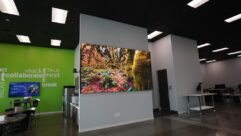
Technology Showcase:
Residential In-wall Speakers
Aug 1, 2006 12:00 PM,
By Bennett Liles
Newest models eliminate weaknesses and the need to compromise in installation.
Sonance Virtuoso V831D
Virtually every challenge posed by mounting speakers directly into walls has been attacked and defeated by some of the latest technology available in this category. New features in in-wall speakers from a wide range of manufacturers now allow such speaker installations to be custom-tailored, in terms of directional throw and frequency response, to the specific room in which they are installed.
At the same time, new construction materials have reduced vibration transfer to surrounding wall structures, while increasing sound pressure levels with less power. These advances have introduced new variety and a range of choices that must be considered to maximize economy and individual suitability for each installation. No two rooms are alike. Differences in room shape, size, carpet, furniture, and even wall decorations can make a noticeable difference in the character of sound from in-wall speaker elements.
The more directional character and reflective properties of the mid-range and upper audible frequencies cause them to be affected most by architectural mounting constraints, and this is where flexibility features have been concentrated. Pivoting tweeters have become quite common, for instance. Some of these are aimed physically, while other models rely on electronic high-frequency vectoring. There are also products whose design enables the entire face of the speaker enclosure to be pivoted up to 20 degrees, with further tweeter vectoring to accommodate room dimensions and seating arrangements. Phase plugs — machined concentric exponential horns mathematically proportioned to help reduce path length and related phase cancellations at higher frequencies — are a frequently mentioned feature in the latest in-wall speaker systems.
Frequency response adjustment is provided on most such products in the form of a two- or three-position high-frequency level switch. Rooms with hard floors and reflective walls can benefit from using the lower setting, while carpeted rooms, which tend to absorb sound in this frequency range, will require higher top-end energy. Obviously, the best spot to judge the effect of these controls is not within an arm’s reach of them, so most models incorporate an infrared “knockout” in the mounting frame. A small, third-party infrared (IR) receiver can be mounted into this hole, and a remote control may be used to operate the various high-frequency vectoring and power adjustments from a normal listening location.
Many of the models now available offer a complete closed-box solution, in which all components are contained in a sealed unit that mounts directly into a wall surface or into a frame, normally installed between wall studs during initial room construction. Among in-wall products are passive units and self-powered models housing speaker and amplifier components. Digital and analog products are also available, but with digital models, it may be advisable to consider adopting the entire sound system from one manufacturer.
Because available products in this category vary in size and shape, while holes cut into walls don’t, it pays to shop carefully and consider all aspects and features of available models before the sheetrock dust starts to fly. Therefore, to help you in this quest, let’s take a quick stroll through today’s in-wall speaker bazaar. The number of companies with products in this area has become quite large, so not all of them are represented here. Instead, the models listed here are a representative sample of some of the best this category has to offer. They span the range from passive, maximum-economy models to cutting-edge digital, IP-addressable gear.

Polk LC265i-IP
RANGE OF OFFERINGS
A recent addition to the extensive line of speaker systems offered by Atlantic Technology, the IWCB-525 is the company’s inaugural entry in the area of in-wall, closed-box loudspeaker systems. Designed to enable a more controlled environment for in-wall installation than is possible with open-air models, the IWCB-525 mounts easily and presents the speaker cabinet, frame, and grille as detachable parts. The frame and grille can be installed and painted to match the room décor, and the speaker cabinet can then be installed to complete a sealed unit.
Bass response goes down to 54Hz thanks to a second 5 1/4in. diaphragm mounted as a bass pressure driver to complement the 5 1/4in. Mica/Graphite loaded polymer cone woofer. Highs are delivered by a silk-dome tweeter, the radiation pattern for which is electronically controlled by the DVC (Directional Vector Control), rather than being physically aimed. The tweeter’s response is also adjusted by the High-Frequency Energy switch for matching high-end response to room acoustics. Further response tailoring is made in the lower mid-range band with the Boundary Compensation toggle to compensate for coloration due to the mounting location. An IR knockout for infrared sensor integration is included in the unit’s front plate. The ICWB-525 retails for $800.
At the top of BG’s line of planar ribbon in-wall speakers is the PD-8 two-way hybrid, featuring a NEO-3 PDR (Progressive Drive and Radiation Technology) Neodymium ribbon tweeter that extends the speaker’s frequency response to 30kHz. The woofer uses a small NRT Neodymium magnet structure combined with a Kevlar cone to allow much higher power-handling capability than would be possible with similarly sized ferrite magnets. The bass response extends downward to 50Hz through a passive crossover set to 2.3kHz.
The entire PD series features high-impact, paintable polycomposite frames, and the installed PD-8 extends only 3.8in. into the wall from the surface. Glass-filled composite dog-toggle clamps facilitate mounting in panel thicknesses from 3/8in. to 1in. with or without the NCB (New Construction Bracket) available for each model. There is also a back box available for all models, except the PD-6LCR, and this is recommended to minimize any leakage into adjacent rooms.
The DSi460T2 from Boston Acoustics can adapt to various installation scenarios with its ability to operate as part of a one-room, multi-speaker array or as a solo speaker carrying both stereo channels. It also sports a selection of dispersion settings with a choice between direct and diffuse throw angles. For single speaker mode, the structure has a pair of wire terminals for each stereo channel. Input modes are selected with a jumper located on the back of the speaker. The unit features a dual-voice-coil 6 1/2in. DCD copolymer woofer and dual 1in. Kortec dome tweeters. Collectively, these provide a 52Hz-to-20kHz frequency response, plus or minus 3dB, with a crossover frequency of 2500Hz and exhibit a power handling capacity of 10W to 125W.
For new construction installations, the NCB6 mounting bracket is available. The DSi460T2 is also equipped with a knockout for installation of a standard 1/2in. diameter infrared remote control sensor. The unit may be painted before or after installation. This versatile speaker system lists for $400.
Using the same 7in. aluminum cone woofer and 1in. aluminum manganese dome tweeter found on the company’s high-end floor standing and compact models, Canton’s InWall 700 includes an acoustically transparent and paintable perforated metal grille and +/-2dB tweeter level adjustment. Power handling of 60W to 100W and a frequency response of 45Hz to 30kHz highlight the unit’s features. The installed depth is 2.8in., and the InWall 700 lists for $300.
As its name implies, Elan Home Systems’ new line of TheaterPoint Home Speaker Systems is aimed squarely at the rapidly expanding home theater market. For these products, the company started from the ground up with a completely new design and specs list, using no existing hardware components.

PSB CW383
Its TSP650W system fills the need for small but powerful L, C, R components. Each unit features a pair of 6.5in. woven Kevlar woofers and a 1in. Kevlar pivoting domed tweeter directed with the Elan laser pointer included for initial setup and calibration. Response tuning is performed with a three-position room compensation switch with bright, neutral, and warm settings. When used with a subwoofer, the THP650W also sports a -20dB bass response limiting switch. Rated for 110W power and 90dB sensitivity with a frequency response of 40Hz to 20kHz, the unit uses a third-order custom Q and slope crossover at 2.2kHz.
The grille and frame are paintable, and a paint shield is included with each order. The speaker mounts into a wall to a depth of 4in. and uses a strong cast frame. In the TheaterPoint line, individual unit prices range from $300 to $700.
Among the in-wall products at the low-end price range with high performance and uncomplicated installation, the ERS 210IIS from Infinity Systems offers a wide 47Hz-to-22kHz frequency response and a power handling capacity up to 125W.
This two-way model uses a 24dB-per-octave crossover at 2300Hz, and incorporates a proprietary waveguide design to provide smooth high-frequency dispersion over the listening area. High-frequency response is delivered by a 3/4in. driver while a 6 1/2in. driver pushes out the low end.
Infinity’s patented Ceramic Metal Matrix diaphragm is designed to provide the most transparent frequency response possible while damping unwanted resonance artifacts. The mounting depth is only 3 1/4in., and the white grilles and frames are paintable to blend with any décor. An optional rough-in frame, the ERS210 RIF, is available. The ERS210 retails for $379 a pair.
Building on the success of its THX Ultra2 speaker line, Klipsch Audio Technologies announced in March the introduction of the in-wall versions of its THX Ultra2 custom home-theater system. Designed for use in rooms of 3,000 cubic feet or larger, the KL-7800-THX uses an 8in. aluminum woofer and a 1in. titanium dome compression driver mated to a square Tractrix Horn and a complete back box enclosure.
The KL-7800-THX and the KS-7800-THX can be mixed and matched with the company’s conventional cabinet THX Ultra2 products. When installed with the Klipsch KW-120-THX subwoofer and the KA-1000-THX subwoofer amplifier, these speakers form the complete THX Ultra2-certified in-wall system. The in-wall KL-7800 THX speakers hit the stores in June this year at $1,000 MSRP.
Among the digital in-wall models, there is a proven product offered as either a digital in-wall or active analog unit. The Meridian Audio DSP420 uses the same drivers and power amplifiers as the more recent M420, while the digital or analog input board and power termination is housed in its own sealed back box. The entire enclosure may be mounted flush for a completely hidden installation, or with a visible grille.
Both units feature separate high- and low-frequency amplification at 65W and 85W, respectively. The analog M420 uses a passive, line-level crossover for bi-amplification, and features XLR connectors from the aluminum back box to the crossover, while the digital DSP420 can be recognized by its rear BNC connectors for input of signals up to 96kHz/24-bit including Meridian High Resolution (MHR) streams from Meridian digital audio products.
Connection of the back box to the digital unit is made via 15-pin D-Sub. The amplifiers, bass drivers, and enclosures of the two models are identical. Of course, this level of speaker technology doesn’t come cheap. The MSRP for the DSP420 is $5,000 and the M420 is around $2,000.
Designed for whole-house sound system distribution, the evoQ 3000 from On-Q/Legrand is available with a single-channel input for installation as part of a one-room, multi-channel setup, or with a single stereo connection when desired as part of a multi-room sound system. Equipped with 6.3in. mica fiber woofers and 3/4in. PEI Mylar tweeters, this model features a frequency response of 50Hz to 20kHz, and a power handling capacity of 150W RMS and 200W peak.
The unit is attached with self-centering screw heads for compatibility with ON-Q pre-construction speaker brackets, and its foam gaskets provide an airtight seal and minimize vibration. The finishing frame with integrated scrim cloth can be painted for a perfect match to any room, and the product is available in round form for in-ceiling installation or rectangle configuration for in-wall mounts.
The evoQ 3000 is available in 6.5in. and 8in. woofers. The 6.5in. woofer model retails for $150 or less.
OWI Incorporated offers two in-wall, three-way speaker products. The larger of these, the IWT83A, has a tough, 8in. aluminum woofer, a 1in. ceramic soft-dome mid-range that can swivel 15 degrees, and a polypropylene tweeter collectively delivering a 55Hz to 20kHz frequency response. A nominal power handling capability of 125W with a peak power of 200W gives the IWT83A plenty of punch, and its aluminum grille is paintable to match any room.
This model is tough enough to mount in a covered outdoor location, and it includes a tweeter protection fuse, a PC board, and a +/-3dB switch. In order to match any installation scenario, including a widely distributed array covering a large room, the IWT83A is available in 8V and 70V models. Kwik Klamps assure easy and solid mounting. The MSRP is $275.

Klipsch KL-7800-THX
With an 8in. woofer, the C-280 is the largest of the in-wall speaker models available from Parasound. For smooth high-frequency response, a dual-chamber aluminum dome tweeter is connected through a three-position, front-panel level control switch. A six-point dogleg mounting system assures a solid fit for the enclosure, while the 24k gold “Constant Pressure” 10 AWG push terminals promise a good wiring connection.
The C-280 boasts a frequency response of 32Hz to 22kHz, plus or minus 3dB, with a 12dB-per-octave crossover network. A power range of 10W to 100W is handled by the 8in. Kevlar woofer. The unit’s chassis contains a sturdy mesh grille with paint shield, a woven dust screen for protection from in-wall debris, and a knockout for mounting an infrared receiver. Once mounted, the C-280 will extend 3 1/2in. into the wall. The MSRP is $535 a pair.
The LC265i-IP from Polk Audio represents a quantum leap in speaker technology with IP addressability. Billed as the world’s first active IP-ready loudspeaker for systems such as NetStreams’ DigiLinX, the unit can also work as a conventional analog speaker, built on the technology of the company’s existing LSi series.
Locally powered digital amplifiers give the units an unprecedented degree of clean power and control. The onboard digital signal processor (DSP) and included room-correction software control the electronic crossover, frequency equalization, bass enhancement, and room correction to allow the LC265i-IP to be custom tailored to a previously impossible level of room response accuracy. Power is electronically distributed to provide 100W to the woofer, 75W to the midrange, and 25W to the tweeter. All this comes from a local 48V DC power supply (not included).
With addition of an optional NetStreams StreamNet card, the unit can connect via Ethernet UTP cable to IP audio distribution systems. Products of this advanced type will be well above the usual in-wall price range. The LC265i-IP, with all its advanced IP technology, lists for $1,500.
The CW383 system from PSB Speakers is an 8in., three-way in-wall speaker system with a rotatable midrange tweeter assembly complemented by a woven fiberglass cone woofer and a 1in. pivoting aluminum dome tweeter with Ferrofluid. These deliver a frequency response of 45Hz to 21kHz, plus or minus 6dB, with a power handling range of 40W to 200W.
There are two baffle-mounted mid- to high-response level-adjust switches for matching the output to room acoustics, and the crossover frequency is 2.2kHz. The ABS plastic finish comes in white, but can be painted. The unit is equipped with a damped rubber surround, and mounting the unit into a minimum 4in. depth is simple with dogleg-style mounting clips. The MSRP for the CW383 is $899.
Introduced at the Consumer Electronics Show (CES) in January as a new addition to the Signature Series from RBH Sound, the SI-6100 system targets the top end of the home theater in-wall market with a 56in. by 14in. medium density fiberboard cabinet that mounts 3 1/2in. deep. Four 6 1/2in. aluminum cone woofers and a 1in. silk dome tweeter push up to 300W with a response from 40Hz to 20kHz, plus or minus 3dB. The 24dB/octave crossover is centered at 2500Hz.
Available with removable black or white grille cloth, this unit is for those who want high-volume sound for a top-end home in-wall system. The product’s MSRP is $1,200.
Among the Advantage Hi-Fi Series products from Russound, the SP-H6IM features a woven glass fiber, long-throw 6.5in. woofer and a pivoting, 20mm aluminum tweeter with a neodymium magnet. Recommended for up to 120W of power handling, the unit provides a frequency response of 45Hz to 20kHz, plus or minus 3dB.
The fine mesh aluminum grille fits into an ABS plastic frame, both of which can be painted to match the wall in which it is mounted. With a quarter-turn, its Twist & Lock fasteners secure the SP-H6IM baffle to the frame in its Iso-Mount. A rough-in bracket is available for new construction installation. For vibration damping, the product includes a thermopolymer isolation gasket between the frame and the baffle. For tailoring response for specific room characteristics, a high-frequency switch is mounted on the front baffle and features a position for flat response and a selection for +3dB high boost. The enclosure requires at least 3 5/8in. wall depth, and includes a knockout for mounting an infrared receiver. The SP-H6IM retails for $525 a pair.
Sonance’s 8in. Virtuoso D Series speakers feature the Pivoting Sonic Eye 4in. carbon fiber cone midrange tweeter assembly to deliver crisp highs at difficult angles. This element is aimed by applying light pressure on the outside edge of the midrange. The 8in. woofer and 3/4in. silk-dome, Ferrofluid-cooled pivoting tweeter collectively deliver 45Hz-to-20kHz response, plus or minus 3dB, with a power handling capacity of 5W to 100W. The mounted depth is 3 7/8in. The structure contains an IR knockout, and the V-831D with paintable grille lists for $600 a pair.
For More Information
Atlantic Technology
www.atlantictechnology.com
Boston Acoustics
www.bostonacoustics.com
Canton
www.canton.de
Elan Home Systems
www.elanhomesystems.com
Infinity Systems
www.infinitysystems.com
Klipsch Audio Technologies
www.klipsch.com
Meridian Audio
www.meridian-audio.com
On-Q/Legrand
www.onqlegrand.com
Parasound
www.parasound.com
Polk Audio
www.polkaudio.com
PSB Speakers International
www.psbspeakers.com
RBH Sound
www.rbhsound.com
Russound
www.russound.com
Sonance
www.sonance.com








